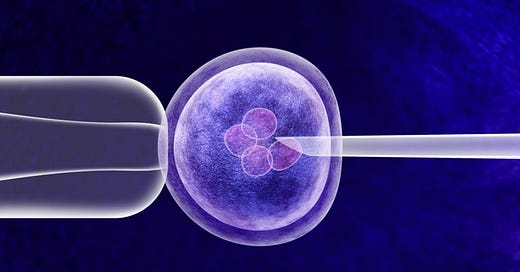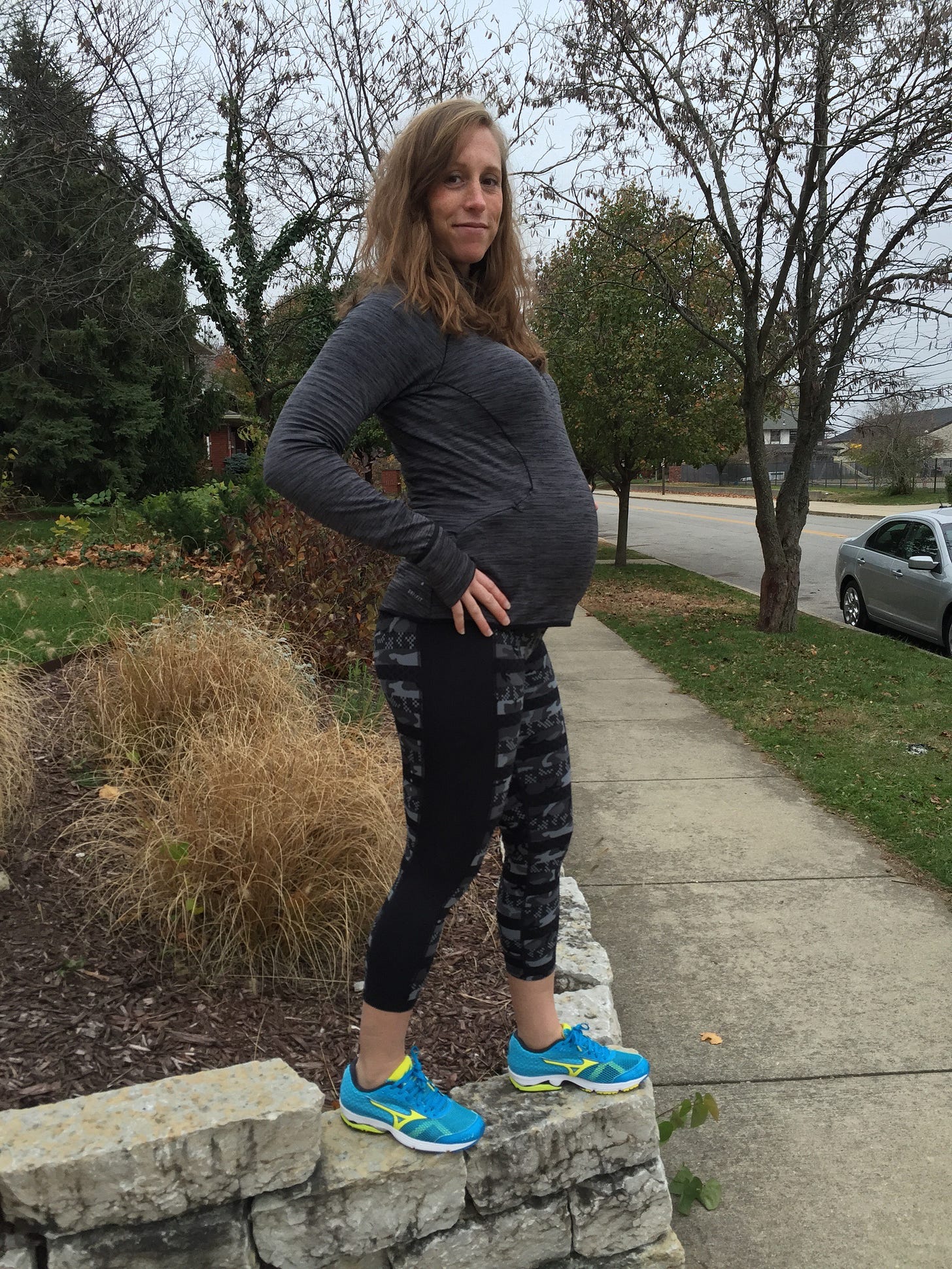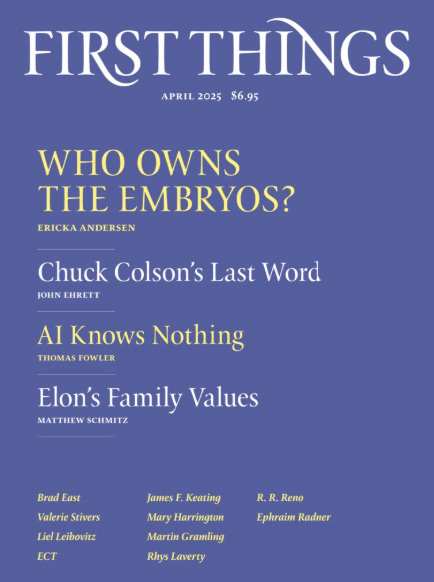➡️➡️ Freely Sober: Rethinking Alcohol Through the Lens of Faith (COMING JANUARY 2026 — GET BOOK UPDATES BY SIGNING UP HERE)
When I first really understood the detailed and unspoken realities of the IVF process, I wished I didn’t. After experiencing several years of infertility, dropping $30k and successfully getting pregnant via traditional IVF. I was lucky, but a difficult reckoning was on the horizon.
If one isn’t affected by infertility, they won’t typically know much about IVF. Friends' innocent curiosity about the process naturally leads to questions about its specifics. I’m generally very open and love to share my experiences, but this one was tricky.
The Devastation of Leftover Embryos [READ]
After all was said and done, my perfect baby boy in my arms, I had “leftover” frozen embryos.” When explaining this to others, I would purposely call them “frozen eggs” in conversation.
But they weren’t eggs. They were fully fused egg and sperm, distinctly created individual human beings with full genetic codes, genders, eye colors, and all the required ingredients for a fully baked person.
And honestly? Most people had no idea the difference or what was true. I couldn’t bear to say “embryos” because it was too real.
My firstborn was immediately transferred from the petri dish to the womb. But for 2 years, my daughter was one of the others who sat frozen in time, waiting for a chance. Every time I look at her sweet face, I can’t help but imagine who else there is…
For several years, I blocked the reality from my mind.
…At the time, I was vaguely familiar with embryo adoption, the option of matching with a family seeking donor embryos to birth and raise on their own, from the beginning. Families who can’t naturally become pregnant sometimes choose this route. Others feel called to adopt embryos just as they would born children.
Desperate to have a baby, I reasoned that if there were extra embryos, that would answer that “problem.” I prayed there would just be three and I would use them all, but I was far from comprehending the magnitude of it all.
I can tell you for sure: Embryo adoption may be the only ethical avenue, but it’s no “answer.” It’s not something you want to have to do.
Today, it’s led to this weird position of being an IVF mom who advocates against traditional IVF. Not because I’m a hypocrite or want people to suffer, but because of my experience and desire to save you from the heartbreak of choosing what you will do with children you cannot raise.
It also led me to ask: What about all of those other frozen embryos out there?
The majority of people abandon, destroy or donate their embryos to science. With over 1.5 million+ embryos on ice in the U.S., and no clear guidance on what to do with them, we’re stuck.
Pushback I’ve heard: In the natural fertility cycle, many embryos are created and die without us even knowing about it. These “extras” are just like those “leftover” frozen ones, some say.
I can understand this reasoning and the comfort it may bring. And yes, many embryos also pass away in the thawing process or do not implant. But with IVF, we’ve inserted ourselves into the process — we become the purveyors of life and death. We genetically test embryos, hoping for the “best” and “strongest” one to survive and produce our heir.
In my “Embryo Adoption” support group on Facebook, people are constantly throwing out what grade their embryos are, like rating jewels or bottles of wine.
— Weaklings are left behind.
— The imperfect sit shelved, never given a chance.
🚨🚨 It’s not because we’re hateful but because we’re human. Of course, we want IVF to work! But it’s less likely to do so if you implant the “weakest” embryo.
It’s eugenic by design.
For this reason, human beings on ice are abandoned in freezers, more of them essentially becoming the property of laboratories every day as parents stop paying storage fees.
🚨🚨 Some vials containing human embryos fall to the bottom of cryotanks without proper labeling, and no one knows who they are or whose they are.
Few, if any, regulations, rules or oversight exist for the businesses that house these pre-born lives and they’re considered “property” in 49 of 50 states. Human beings cannot and should not be owned by another.
Frozen embryos aren’t treated with dignity but as scientific substances. Yet, there is an unacknowledged sacredness from all involved: they are not merely substances and can’t be destroyed willy-nilly because we all know what they really are.
Even if families inexplicably stop paying the storage fees, and facilities can legally destroy the “property", it’s difficult for these businesses to unthaw the embryos without hesitation. That’s because they know there could be legal repercussions if parents don’t sign legal consent for destruction. And, after all, you can’t just kill someone else’s child, even if they did abandon them.
My piece in the Wall Street Journal:
Who “Owns” the Abandoned Embryos?
The fate of these millions of mini-lives is often at the hands of inhumane people factories who will eventually tire of “housing” them for free after parents stop paying the storage fees.
Why don’t the parents just make a choice? You might wonder that. But I can tell you the answer: They don’t want to face it.
They don’t want to choose to destroy the embryos because they’re breathing children came from the same batch.
They don’t want to put them up for embryo adoption because then they’d have to deal with the reality of their flesh and blood alive in the world somewhere without them.
🚨🚨 A person might one day knock on their door or send them an email and ask them: why didn’t you want me? Why did you give me away? Why wasn’t I the chosen one?
Your breathing children will one day know they have a full sibling out there, which causes hardship for them. The adopted child will be disconnected from their biological family, may struggle with identity issues, and incur all the same early traumas that any other newborn adoptee would have.
It’s a problem with no answer for those already in the situation. It’s why I write articles like the one I recently published in First Things:
Who Owns the Embryos?
by Ericka Andersen
*The following are excerpts from First Things. Where you see ellipses, I’ve skipped certain paragraphs. I’ve placed 🚨 symbols in areas that are particularly troubling and should be more widely known!
You can read the full piece here.
…In embryo adoption, an unrelated embryo is placed in a woman’s uterus by means of the same method used in IVF. Embryo adoption can be more reliable than traditional newborn adoption, as it eliminates the risk of a birth mother’s changing her mind. Closed embryo adoptions, wherein information about the adopting family is hidden, also remove the pressure of needing to be “chosen” by the birth family.
…Given how rarely clinics and facilities report their errors and issues, the parents will have no idea what ultimately happens to their embryos. As Adam B. Wolf, an attorney for fertility plaintiffs, said in the Washington Post, “The vast, vast supermajority of mistakes in fertility clinics, the public doesn’t even know about.” 🚨🚨
Because frozen embryos are classified as “property” in 49 of 50 states, they have no “right to life.” 🚨
Their status is loosely regulated and rarely monitored, with the result that little legal guidance exists for resolving disputes around ownership or parentage.
In consequence, donated embryos and embryos frozen indefinitely with unpaid storage fees are at risk of destruction, loss, or misidentification. Heritage Foundation researcher Emma Waters calls the U.S. the “wild west” of IVF, surrogacy, and embryo adoption due to this lack of oversight.
Susan Crockin, a reproductive law expert at Georgetown University, told the Associated Press in 2019 that the courts view an embryo as something (in the AP’s summary) “between person and property.”
For example, it’s uncommon to allow one spouse to use an embryo over the other’s objection. In other words, the courts have determined that the right of one person to avoid having additional children takes precedence over the right of the other to use the embryos.
Although the embryo is legally viewed as property, the courts have been reluctant to permit its “use” without the permission of both parents.
The United States’ unregulated IVF and surrogacy industries treat human embryos as disposable commodities, creating multiple ethical and legal dilemmas.
🚨🚨 Not since the nineteenth century have human beings been classified as property. And the result—even setting aside questions of human dignity and the sanctity of life—can be a legal nightmare for those caught up in it.
…After last year’s Alabama case, wherein the accidental destruction of embryos was declared “wrongful death,” the questions of embryo ownership and the classification of embryos as “property” are more important than ever.
In Alabama, the Wrongful Death of a Minor Act encompassed all unborn children, no matter their age or location. And the parents who had been awaiting the frozen embryo transfers understandably felt that their children had been killed.
Human Beings as Property
Frozen embryos may be the most basic form of human life, but they are, as any textbook confirms, human beings. Yet in nearly every state, they are considered “personal property.”
In a troubling 2023 case, a Virginia judge used a nineteenth-century law, originally meant to regulate slaves, to rule that frozen embryos could be classified as property. The embryos, in this case, were part of a divorce settlement, with the wife seeking to use them while the husband opposed their use.
The judge’s use of this precedent illuminates the larger society’s view of embryos—as members of some other species. As the ethicist Charles Camosy puts it:
“Imagine a human being who is a captive, an orphan, and a (quite) little child that the surrounding culture deems a non-person all in one.”
In a 1989 Tennessee case wherein a divorcing couple argued over the rights of their frozen embryos, Jerome Lejeune, professor of fundamental genetics at Medicine of Paris, testified concerning the concept of frozen embryos as “property”:
“I would say that science has a very simple conception of man; as soon as he has been conceived, a man is a man,” said Lejeune.
The American College of Pediatricians corroborates this understanding: “a unique human life starts when the sperm and egg bind to each other in a process of fusion of their respective membranes and a single hybrid cell called a zygote, or one-cell embryo, is created.”
This embryo, write Robert P. George and Christopher Tollefsen in Embryo: A Defense of Human Life, “is a whole living member of the species, Homo Sapiens, in the earliest stage of his natural development.”
Even those who would decline the ultimate conclusions of Lejeune, George, and Tollefsen often hedge on the issue of an embryo’s ultimate value.
“I don’t think an embryo is a person, but I do think an embryo deserves special status,” West Coast Fertility Center owner & physician Dr. Vitaly Kushnir told the Washington Post last year.
America’s legal language needs to catch up.
Frozen embryos left over from tens of thousands of successful IVF cycles are being kept in limbo, with no sure pathway to birth. The fate of millions is unrealized, partly because regulation of the fertility industry is haphazard.
And when human embryos become a source of profit, unsafe practices, legal battles, and exploitation will arise.
For fertility clinics in the US, accreditation and inspections are neither required nor enforced. The 1992 Fertility Clinic Success Rate and Certification Act required clinics to report data.
But without penalties for non-compliance, we lack insight into what happens behind the clinics’ doors. 🚨🚨
Without standards, frozen embryos are left unprotected. The American Society for Reproductive Medicine highlights errors in cryostorage, such as:
✔️ Mislabeled or unlabeled embryos 🚨
✔️ Poor inventory records 🚨
✔️ Insufficient storage tank tracking 🚨
Lack of oversight has also led to at least one case of the wrong embryo’s being transferred, and to a freezer malfunction that destroyed 4,000 eggs and embryos.
The Rights of Embryos
…However, for patients unwilling to donate their embryos for adoption, it is common to stop paying those fees, which can range from $500 to $1,500 annually. The clinics that store these embryos are often left wondering what to do next.
Some clinics say that 🚨 up to 18% 🚨 of their embryos will ultimately be abandoned due to nonpayment of storage fees. When this happens, clinics often store the embryos indefinitely. With no paperwork granting legal permission to destroy the orphaned embryos, facilities risk lawsuits if the parents ever come back demanding their “property.” In consequence, many embryos languish without a destination for years.
Craig Sweet, medical director of Embryo Donation International, published a study showing that at least one-third of IVF cycles result in excess embryos, and that up to 24 percent of patients ultimately destroyed their by choice or abandoned them by nonpayment of storage fees.
When parents stop paying storage fees, the clinic must decide how long to keep the embryos frozen.
🚨 According to Sweet, embryos in storage might stay as they are “for centuries” if clinics don’t dispose of them.
Today, there are an estimated 1.3 million frozen embryos in the United States (the actual number is not known because of a lack of reporting requirements.)
The American Society for Reproductive Medicine says that when patients have not paid their storage fees and there has been no contact, facilities may thaw the embryos in preparation for transferring them to other adopters—but they may not transfer them without explicit written permission from the previous owners.
Thus, “unpaid for” embryos have no one looking out for them. 🚨
Most families with frozen embryos do not consider the embryos “people,” and yet they still struggle to let go. Often, their feelings are contradictory and confused. As one woman in a forum put it, “I know the embryos are not babies…but I’m so sad at the thought of those tiny blobs defrosting and disappearing.”
Another, who described herself as “not religious,” said she feels bad thinking that “the embryos could have wound up as our child and it would feel like we were discarding two of our [daughters].”
When people become “property,” the results can be surreal. In one example, reported by the New York Times, one couple was shocked to receive a storage fee invoice, for frozen embryos they had been told didn’t exist more than 20 years prior. 🚨🚨
After undergoing IVF and successfully birthing one child, they had been told none of their other embryos survived the process. It may have been an honest mistake by the staff, but two decades later, a belated inventory turned up two vials containing their frozen embryos on the floor of a cryo tank.
In the interim, the couple had lost their chance to conceive again. Paperwork for storage fees was nevertheless filed and sent to them, as if no time had passed.
How We Got Here
Fertility technology has given millions of people the opportunity to create families, even as it devalues human life. Doctors create excess embryos to maximize the chances of a healthy baby, but the embryos left frozen are often treated as mere possessions.
🚨🚨 The IVF industry has also commercialized “double donor” IVF, wherein adoptive parents select an embryo created from anonymously donated egg and sperm—a process that raises numerous ethical concerns about that child’s right to knowledge of and relationship with their biological parents.
…This questions of rights and ownership surrounding indefinitely frozen embryos will persist. Tens of thousands more embryos are frozen in IVF cycles every year. Those who are lucky enough to be born, by means of embryo adoption, may face their own struggles.
Worth Your Time is reader-supported. To receive new posts & support my work, consider becoming a free or paid subscriber ❤️
The best way to support this newsletter is to buy a copy of my books, share, and leave a review on Amazon + Goodreads. I appreciate every single purchase + review!
Reason to Return: Why Women Need the Church & the Church Needs Women
Leaving Cloud 9: The True Story of a Life Resurrected From the Ashes of Poverty, Trauma and Mental Illness
Freely Sober: Rethinking Alcohol Through the Lens of Faith (coming soon — click for updates!)
Learn more about Ericka Andersen here.











Wow Ericka wow! I am nearly speechless. Thank you for pouring your heart into this. As someone who works with families in the perinatal stage of life and beyond into postpartum, I get a fair share of IVF parents. I am so curious how this process is dissected by those families.
Thank you for your willingness to write on such a hot topic. I hope those who have embryos they won't be using, consider putting them up for adoption, even with the potential emotional toll.